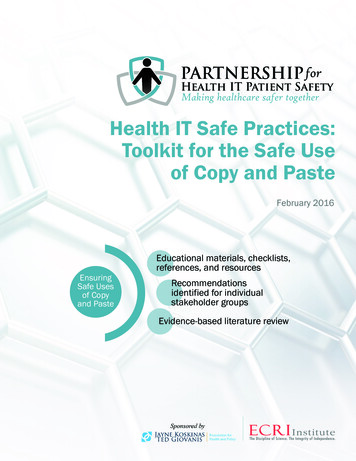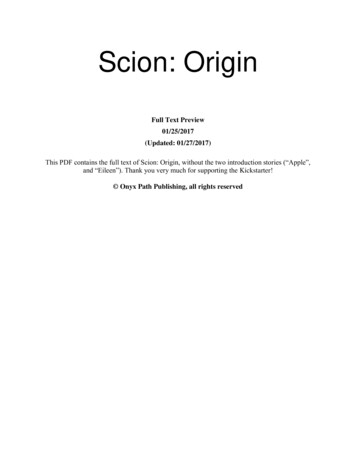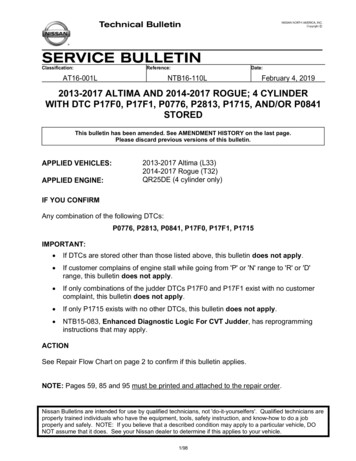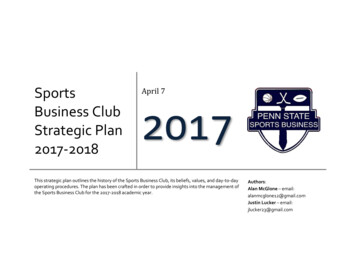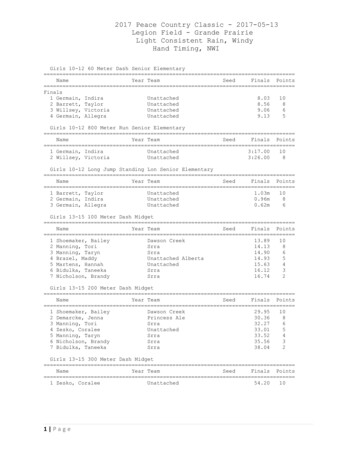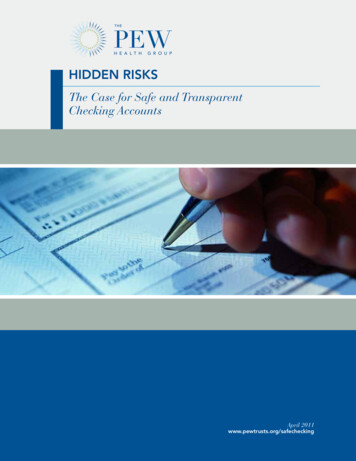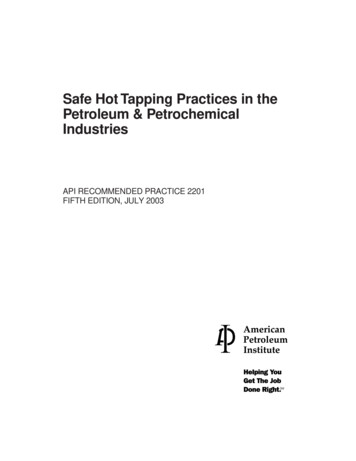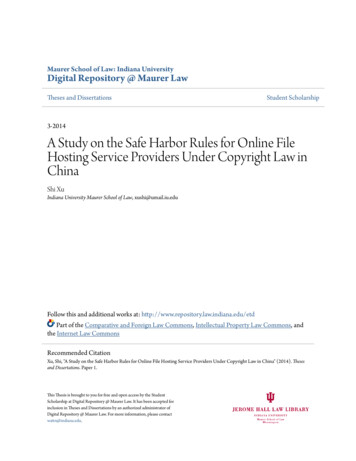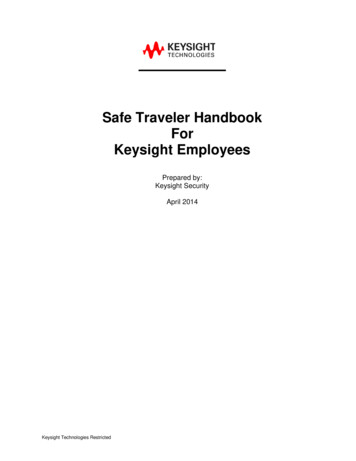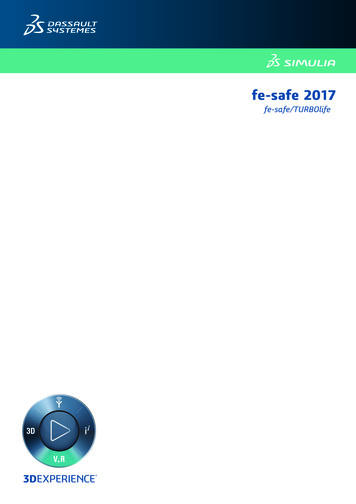
Transcription
fe-safe 2017fe-safe/TURBOlife
ContentsContents123Introduction to fe-safe/TURBOlife. 91.1About fe-safe . 91.2About fe-safe/TURBOlife. 91.3How to use this manual . 10Features of fe-safe/TURBOlife . 112.1Introduction . 112.2Features . 122.2.1Introduction . 122.2.2Assessment point. 122.2.3Component loading history . 132.2.4Stress calculation . 132.2.5Materials data . 142.2.6Plastic relaxation . 152.2.7Creep relaxation. 162.2.8Cycle recognition . 162.2.9Damage calculations . 16Material properties . 173.1Material data requisites . 173.2General material parameters . 173.4TURBOlife parameters . 183.5Stress-strain and hysteresis curves and cyclic hardening . 183.6Strain life curve . 233.7Creep deformation tables . 263.8Creep ductility damage parameters . 273.9Creep fatigue interaction diagram . 323.10 Strain range partitioning . 344Creep-fatigue analysis using fe-safe/TURBOlife. 374.1Overview of analysis technique . 374.2Loading . 384.2.12FEA results . 38fe-safe/TURBOlife User ManualCopyright 2016 Dassault Systemes Simulia Corp.Issue: 4.0 Date: 07.09.16
Temperature definition .394.2.3Time definition .394.2.4Complex loading .424.2.5Recommendations .434.3Materials data.444.4Selecting analysis .444.5Analysis Options .454.64.5.1Plasticity Method .464.5.2Generalised Stress Parameter .464.5.3Creep Table that Takes Precedence .464.5.4Elastic follow-up factor, 1/Z (0- 1) .474.5.5Maximum diagnostics table size (DE) .474.5.6Maximum iterations of loading (DE) .474.5.7Maximum iterations per FOS (DE) .484.5.8Creep contour value for 0 damage (%) (DE) .48Analysing and results .484.6.1Ductility Exhaustion .494.6.2Strain Range Partitioning .524.7FOS calculations .554.8Extra diagnostics .554.954.2.24.8.1Load Histories (plot files) .554.8.2Export TURBOlife plots (plot files) .574.8.3Export TURBOlife tables (.log file) .604.8.4Block life table (.log file) .614.8.5Item information and critical-plane orientation (.log file) .624.8.6Export dataset stresses (.log file) .634.8.7Loading stress, strain and temperature (.log file) .634.8.8Export FOS plane tracking table (.log file) .63Analysis limitations .63Methodologies and procedures for creep-fatigue endurance assessment . 655.1Introduction .655.2Predictive methods for creep-fatigue endurance assessment .655.2.1Elements of a methodology .65Copyright 2016 Dassault Systemes Simulia Corp.Issue: 4.0 Date: 07.09.16fe-safe/TURBOlife User Manual3
Contents5.365.2.2Stress-strain behaviour . 655.2.3Damage modelling . 66Design and assessment procedures . 665.3.1Background . 665.3.2ASME NH . 665.3.3RCC – MR . 675.3.4British Standards. 675.3.5R5 procedure . 67Strain-based methods in thermo-mechanical creep-fatigue endurance assessment . 696.16.26.36.46.5Experimental observations of deformation behaviour . 696.1.1Engineering stress/strain curve (tensile test) . 696.1.2True stress and strain definitions . 706.1.3True stress/strain tensile curve . 716.1.4Stress and strain under cyclic conditions . 726.1.5Stress and strain concentration factors (elastic follow-up) . 746.1.6Time dependent behaviour . 756.1.7Multiaxial effects . 77Presentation of creep data . 786.2.1Creep curves . 786.2.2Isochronous curves . 79Creep under variable stress . 796.3.1Creep relaxation. 796.3.2Equation of state approach to variable loading . 806.3.3Time hardening and strain hardening . 806.3.4The elastic follow-up factor . 826.3.5Multiaxial effects . 84Creep damage and component failure . 846.4.1Creep damage mechanisms . 846.4.2Creep strain at failure . 856.4.3Creep ductility versus creep strain rate . 876.4.4Multiaxial effects . 88Influence of creep strain on fatigue damage . 896.5.14Fatigue damage mechanisms . 89fe-safe/TURBOlife User ManualCopyright 2016 Dassault Systemes Simulia Corp.Issue: 4.0 Date: 07.09.16
76.5.2Fatigue damage summation .906.5.3Experimental observations of creep-fatigue interaction .916.5.4Creep-fatigue interaction diagram .94Tutorial: Creep fatigue analysis using fe-safe/TURBOlife . 957.1Introduction .957.2Preparation.957.3Opening the sample FE model .967.4Exercise 1: Using the Ductility Exhaustion method .997.5Exercise 2: Using the Strain Range Partitioning method .1148Nomenclature . 1199References. 121Copyright 2016 Dassault Systemes Simulia Corp.Issue: 4.0 Date: 07.09.16fe-safe/TURBOlife User Manual5
Trademarksfe-safe, Abaqus, Isight, Tosca, the 3DS logo, and SIMULIA are commercial trademarks or registered trademarks ofDassault Systèmes or its subsidiaries in the United States and/or other countries. Use of any Dassault Systèmes orits subsidiaries trademarks is subject to their express written approval. Other company, product, and servicenames may be trademarks or service marks of their respective owners.Legal Noticesfe-safe and this documentation may be used or reproduced only in accordance with the terms of the softwarelicense agreement signed by the customer, or, absent such an agreement, the then current software licenseagreement to which the documentation relates.This documentation and the software described in this documentation are subject to change without prior notice.Dassault Systèmes and its subsidiaries shall not be responsible for the consequences of any errors or omissionsthat may appear in this documentation. Dassault Systèmes Simulia Corp, 2016.6fe-safe/TURBOlife User ManualCopyright 2016 Dassault Systemes Simulia Corp.Issue: 4.0 Date: 07.09.16
Third-Party Copyright NoticesCertain portions of fe-safe contain elements subject to copyright owned by the entities listed below. Battelle Endurica LLC Amec Foster Wheeler Nuclear UK Limitedfe-safe Licensed Programs may include open source software components. Source code for these components isavailable if required by the license.The open source software components are grouped under the applicable licensing terms. Where required, links tocommon license terms are included below.IP Asset NameIPAssetCopyright NoticeVersionUnder BSD 2-ClauseUnZip (from Info-2.4ZIP)Copyright (c) 1990-2009 Info-ZIP. All rightsreserved.Under BSD 3-ClauseQt diary(-ies)All rights reserved.Copyright 2016 Dassault Systemes Simulia Corp.Issue: 4.0 Date: 07.09.16fe-safe/TURBOlife User Manual7
8fe-safe/TURBOlife User ManualCopyright 2016 Dassault Systemes Simulia Corp.Issue: 4.0 Date: 07.09.16
Introduction to fe-safe/TURBOlife1Introduction to fe-safe/TURBOlife1.1About fe-safefe-safe is a powerful, comprehensive and easy-to-use suite of fatigue analysis software for Finite Element models.It is used alongside commercial FEA software to calculate: where fatigue cracks will occur; when fatigue cracks will initiate; the factors of safety on working stresses (for rapid optimisation); the probability of survival at different service lives (the ‘warranty claim’ curve).Results are presented as contour plots which can be plotted using standard FE viewers.fe-safe has direct interfaces to the leading FEA suites.1.2About fe-safe/TURBOlifefe-safe/TURBOlife is an add-on module for use with fe-safe fatigue analysis software, that can be used for theanalysis of any engineering component, which operates hot and cyclically resulting in creep-fatigue damage. Usersof fe-safe/TURBOlife are assumed to have a working knowledge of fe-safe, including such techniques asconfiguring a fatigue analysis and setting properties for different parts of the model, defining the fatigue loading,running an analysis and exporting fatigue results. The use and application of fe-safe is described in the fe-safeUser Manual, which should be referred to alongside the fe-safe/TURBOlife manual.fe-safe/TURBOlife is a joint collaboration between AMEC and Dassault Systèmes. fe-safe/TURBOlife performscreep-fatigue crack initiation calculations for engineering components under thermo-mechanical loading. Twomethods are provided: Ductility Exhaustion and Strain Range Partitioning.Ductility Exhaustion (DE)This method is developed from the R5 document, volumes 2 and 3, although there are some important andsignificant differences and extensions.Stress analysis for the component is performed elastically by finite element analysis to describe the load cycle or asequence of load cycles. Plasticity and relaxation methods are then used to calculate plastic strain and creep strainat a node for the load sequence and construct the stress-strain history. Individual cycles and unmatched half cyclesare identified. Fatigue endurance is calculated using a strain-life approach and creep life is calculated using acreep ductility exhaustion method. Creep fatigue-interaction is accounted for by means of a creep-fatigueinteraction diagram.Strain Range Partitioning (SRP)This method is based on work by Manson, Halford and Hirschberg. It is aimed at separating a strain cycle into itsstrain component behaviours and then evaluating the damage attributable to each. The strain components arecreep and plasticity.AMEC backgroundOver the past twenty five years, extensive research has been undertaken collaboratively by various companies inthe UK power generation sector, concerned with the understanding of thermal-mechanical and creep-fatigueCopyright 2016 Dassault Systemes Simulia Corp.Issue: 4.0 Date: 07.09.16fe-safe/TURBOlife User Manual9
Introduction to fe-safe/TURBOlifedamage mechanisms. AMEC (formerly Serco Assurance, AEA Technology Consulting and before that part of theUnited Kingdom Atomic Energy Authority) has contributed extensively to this research. The need was driven byincompatibilities between the type of failure observed in laboratory material tests and in plant components, alongwith the need for realistic estimation of thermal-mechanical fatigue damage for safe design and operation. This ledto the development of a component and material specific strain based procedure, as an alternative to the timebased British Standard and ASME approaches.R5 backgroundThe UK strain based development is the basis of both the R5 assessment procedure used extensively in the powerindustry and this software. The R5 assessment procedure is the only procedure used in the UK for hightemperature assessments of nuclear power stations.1.3How to use this manualThis document describes features of the fe-safe/TURBOlife software in Chapter 2, the material propertyrequirements in Chapter 3 and the means by which an assessment is performed in Chapter 4. Chapter 7 gives atutorial example which can be followed using the software where the necessary finite element analysis results andmaterial properties are included as data files. Chapter 5 covers background notes on creep-fatigue methodologiesin general and Chapter 6 strain based methods in particular.Users new to fe-safeBecause this manual assumes some familiarity with fe-safe, it will be necessary to learn a little about the mainprogram first. Work through some of the tutorials in the fe-safe User Manual, including at least one demonstratingthe use of data from your preferred FEA software, then return here.fe-safe users new to TURBOlifeWork through the tutorial, and then follow the procedure described in Chapter 4 with your own data, referring toChapter 2 as necessary.Experienced users of fe-safe/TURBOlifeExperienced users are most likely to refer to Chapters 2 and 4, which provide a detailed reference, includingdescriptions of infrequently-used parameters.10fe-safe/TURBOlife User ManualCopyright 2016 Dassault Systemes Simulia Corp.Issue: 4.0 Date: 07.09.16
Features of fe-safe/TURBOlife2Features of fe-safe/TURBOlife2.1Introductionfe-safe/TURBOlife algorithms continuously assess creep and fatigue damage individually and the known effect oftheir interaction on a component operating with cyclic mechanical and thermal loads. The creep-fatigue damageduring an operating time increment is assessed and added to the damage from the previous time increment todetermine the current total damage. There is no restriction to the magnitude of the time increment that can be usedand the calculation accuracy of creep strain and creep damage does not require a small time increment. However,with small time increments the damage calculation can accurately follow any component load history without theneed to assume the repetition of particular cycles. On-line versions of the software are used to continuouslymonitor damage to power station boilers and gas turbine blades using transducer inputs that follow actual plantoperation. For on-line applications the software recognises real operating cycles as they occur, thereby providingcontinuous information in real time on actual plant usage.An essential element of the strain-based approach is the understanding of damage mechanisms associated withelevated temperature thermal-mechanical, creep-fatigue failure of laboratory material and feature tests. Fatiguedamage concerns the initiation and growth of cracks at the free surface. Creep damage concerns the initiation andcoalescence of voids to form cracks along grain boundaries, and as such affects the bulk of the material. At lowstrain ranges creep cracking alone can occur. At higher strain ranges, such as at stress concentrating features,surface fatigue cracks can initiate and trigger the coalescence of creep induced voids. Thus thermal-mechanical,creep-fatigue interaction can occur. This understanding of material mechanisms at a fundamental level is thenreconstituted into estimates of component thermal-mechanical fatigue life. In this process it is not sufficient toperform the damage calculation for a single cycle and multiply the result by the number of cycles. This is for anumber of reasons: Cyclic hardening changes the stress range and the instantaneous creep rate at any instant in acycle is dependent on current stress. The instantaneous creep rate is also dependent on the total time since creep straining began, notsimply the time period for any single cycle. The instantaneous creep ductility used to assess the instantaneous creep damage incrementdepends on the current creep strain rate. The fatigue damage for a cycle depends on the total strain range for that cycle, including creepstrain.Therefore, for sensible creep-fatigue damage assessments, the analysis of a full cyclic stress-strain time history isrequired, even though that time history may be comprised of a series of identical load cycles. To perform thesecalculations the TURBOlife algorithms include a number of features, most of which operate automatically but someof which have aspects that are user controlled. These are: materials data interpolation and extrapolationCopyright 2016 Dassault Systemes Simulia Corp.Issue: 4.0 Date: 07.09.16fe-safe/TURBOlife User Manual11
Features of fe-safe/TURBOlife multi-axial loading component size and geometric features thermal and mechanical load behaviour temperature dependent material properties elastic follow-up strain analysis hysteresis loop development with strain hardening cycle recognition by half cycle matching fatigue damage assessment including creep strain creep damage assessment creep-fatigue interaction damage creep-fatigue damage using Strain Range Partitioning residual life assessmentThus the fe-safe/TURBOlife software recognises and accounts for the total history effects, history independentstate variable effects, and component specific effects, all of which are known to influence thermal-mechanical,creep-fatigue failure. These aspects are not be adequately accounted for in the more traditional phenomenologicalapproaches, which use laboratory tests to characterise material test specimens, which are then assumed totransfer directly to component assessment. Also, these effects are not included in simplified damage methods suchas time-temperature fraction accounting using the Larson-Miller parameter.Outputs of a fe-safe/TURBOlife analysis are either in the form of creep-fatigue contours showing damage ‘hotspots’ or detailed tabular output for each nodal point of the finite element mesh.2.2Features2.2.1IntroductionThe following text provides a general description of the fe-safe/TURBOlife software functionality. Various featuresof the software are described and reasons for the inclusion of these features are given. Where appropriate, limits orconditions are given that define the scope of problem that can appropriately be considered by the software. Alsoguidance is given on electing certain parameters controlled by the user.2.2.2Assessment pointCalculations are performed for all nodes on a finite element mesh representing the component geometry. Theintention is to identify creep damage or creep-fatigue damage ‘hot spots’ due to local stress concentrating features,regions of high thermal stress or regions of high temperature. To perform this overall function expediently, it isassumed that the component has shaken down to cyclic behaviour that is essentially elastic. This means that localregions of cyclic plasticity are allowed but gross plasticity across load bearing sections of the component arebeyond the scope of the TURBOlife methodology. Local cyclic plasticity is defined as extending over no more than20% of load bearing sections. This assumption limits the extent of the plastic relaxation behaviour in plasticenclaves so that the behaviour can be described by simple methods. For pure thermal loading with no mechanicalload, this 20% limit is less restrictive.12fe-safe/TURBOlife User ManualCopyright 2016 Dassault Systemes Simulia Corp.Issue: 4.0 Date: 07.09.16
Features of fe-safe/TURBOlifeThe assumption of limited plasticity is not unduly restrictive for practical purposes. This is because the enduranceof high temperature components subjected to creep damage would be very low if mechanical stresses are not keptsmall.The assessment points are therefore assumed to behave independently in that the stress redistribution across theentire component to account for force equilibrium and displacement compatibility are not considered. Thealternative to this assumption is to perform full elastic-plastic finite element analysis for all cycles experience by thecomponent, possibly leading to computational difficulties.2.2.3Component loading historyElastic finite element analysis of the component including all boundary conditions is required. Mechanical andthermal load cases may be considered separately and summed or they can be combined into a single load case.The finite element analysis must consider a full cycle of loading. The form of the finite element output is a set of sixstress components, being three direct stresses and three shear stresses. Stresses are specified in time sequencewhere the time increment between stress sets need not be constant. There is no loss of accuracy in plasticity orcreep calculations where large time steps are used.However, the time increment must be sufficiently small that the cycle analysis adequately captures peaks andtroughs. To achieve this it is recommended that elastic stress increments should usually be limited to 10 MPa orless. Where thermal analysis is included, the calculated component nodal temperatures are used to selectappropriate material properties. Again the thermal time step increment need not be constant. However it isrecommended that nodal temperatures changes per time increment should not normally exceed 10 C so that cyclictemperature changes are adequately described. Metal temperature change is governed by the heat transfercoefficient coupling the heat transfer fluid to the metal surface. The following table gives guidance on the maximumtime increme
fe-safe and this documentation may be used or reproduced only in accordance with the terms of the software license agreement signed by the customer, or, absent such an agreement, the then current software license agree
